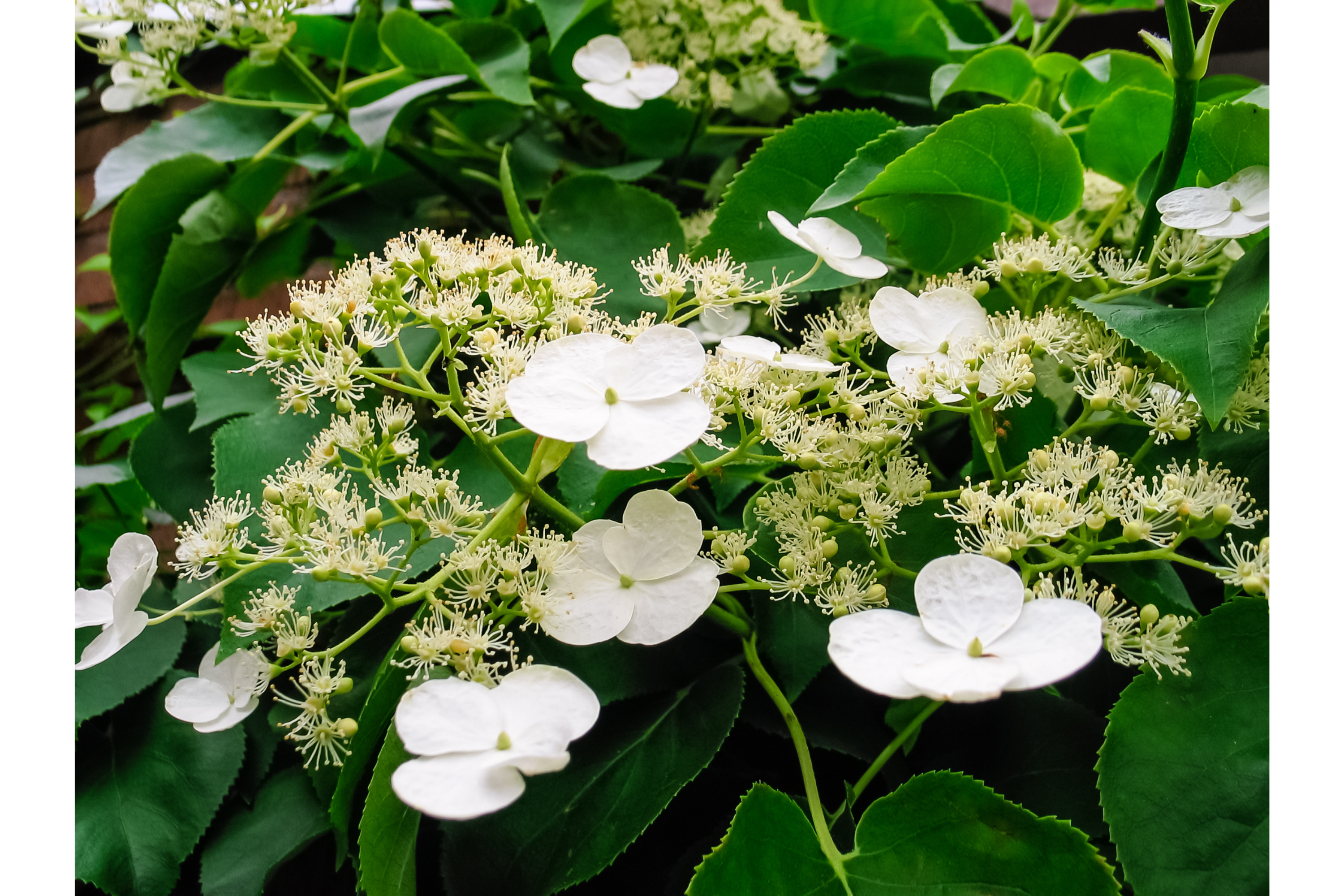Climbing hydrangea
(Hydrangea anomala)

Description
Hydrangea anomala is a species of flowering plant in the family Hydrangeaceae. This plant is commonly known as the climbing hydrangea, due to its ability to grow up walls, trees, and other vertical surfaces. Hydrangea anomala is native to the forests of Japan, Korea, and Taiwan, where it grows as an epiphyte or a lithophyte, meaning it attaches itself to trees or rocks. This plant is highly valued for its ornamental qualities, and is a popular choice for gardeners and landscapers around the world. Description Hydrangea anomala is a deciduous woody vine that can grow up to 80 feet (24 meters) in length. It has long, dark green leaves that are ovate to heart-shaped, with serrated edges. The leaves can grow up to 4 inches (10 cm) long and 3 inches (7.5 cm) wide. In early summer, the plant produces large, flat-topped clusters of white or creamy-white flowers, each with four or five petals. The flowers can grow up to 8 inches (20 cm) in diameter and are highly fragrant. After the flowers fade, the plant produces brown woody seed capsules. Cultivation Hydrangea anomala is a relatively easy plant to grow, and is well suited to a variety of growing conditions. It prefers partial shade and moist, well-drained soil, but can tolerate full sun and a range of soil types. The plant is hardy to USDA Zones 4 to 8, which means it can withstand temperatures as low as -30°F (-34°C). The climbing hydrangea can be propagated by seed or by taking stem cuttings in early summer. It is important to note that this plant can take several years to establish and may not flower for the first few years after planting. Uses Hydrangea anomala is primarily grown for its ornamental value. The plant's ability to climb makes it an excellent choice for covering walls, fences, and other structures. It can also be trained to grow on trellises or arbors, where it will provide a stunning backdrop to other plants. The large, showy flowers of the climbing hydrangea make it a popular choice for cut flower arrangements, and the plant is also used in traditional herbal medicine for its anti-inflammatory and analgesic properties. Pests and Diseases Hydrangea anomala is generally resistant to pests and diseases, but it can be susceptible to a few common problems. The most common pests include aphids, scale insects, and spider mites, which can be controlled with insecticidal soap or horticultural oil. The plant can also be affected by fungal diseases such as powdery mildew, leaf spot, and botrytis blight. These diseases can be prevented by providing good air circulation and avoiding overhead watering. Varieties There are several varieties and cultivars of Hydrangea anomala that are commonly grown for their ornamental value. These include: Hydrangea anomala subsp. petiolaris: This is the most common variety of climbing hydrangea, and is often simply referred to as the climbing hydrangea. It has dark green leaves and large, fragrant white flowers. Hydrangea anomala subsp. petiolaris 'Miranda': This cultivar has variegated leaves with green edges and cream-colored centers. It produces the same large, fragrant white flowers as the species. Hydrangea anomala subsp. petiolaris 'Moonlight': This cultivar has chartreuse-colored leaves that turn yellow in the fall. It produces white flowers with a hint of green. Hydrangea anomala subsp. petiolaris 'Silver Lining': This cultivar has silver-gray leaves with green edges. It produces white flowers that are slightly smaller than those of the species. Hydrangea anomala subsp. petiolaris 'Firefly': This cultivar has bright chartreuse leaves that turn yellow in the fall. It produces white flowers that are slightly smaller than those of the species. Hydrangea anomala subsp. petiolaris 'Spring Grove': This cultivar has larger leaves than the species, and produces larger, more abundant flowers. It also tends to grow more quickly than other cultivars. Overall, the varieties and cultivars of Hydrangea anomala offer a range of colors and foliage patterns, making it easy to find a plant that will suit your garden's needs. Conservation Status The conservation status of Hydrangea anomala is currently listed as "Least Concern" by the International Union for Conservation of Nature (IUCN). This means that the species is not currently considered to be at risk of extinction. Although Hydrangea anomala is native to several Asian countries, it has been widely cultivated and naturalized in other parts of the world, including North America and Europe. In some cases, the plant has become invasive and is considered a threat to native plant species. However, overall, the species is not considered to be in danger of extinction. Despite its relatively secure conservation status, it is still important to protect and preserve Hydrangea anomala and other plant species. This can be achieved through conservation efforts such as habitat preservation, seed banking, and education and outreach programs to raise awareness about the importance of biodiversity and the need to protect our natural resources.
Taxonomic tree:







